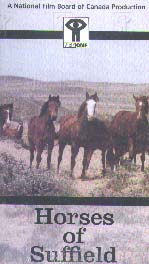|
________________
CM . . . .
Volume VII Number 2 . . . . September 22, 2000


|
Horses of Suffield.
Nick Bakyta (Director). Katherine Rankin & Jerry Krepakevich (Producers).
Montreal, PQ: National Film Board of Canada, 1998.
46 min., 39 sec., VHS, $39.95.
Order Number: C9198 027.
Subject Headings:
Wild horses-Alberta-Suffield Region.
Suffield Region (Alta.)-Environmental conditions.
Grades 7 and up / Ages 12 and up.
Review by Ruth McMahon.
** /4
|

In 1994 (although the video does not mention the date of this episode), the feral horses that made
their home at Canadian Forces Base Suffield were rounded up and adopted by citizens from
across Canada. This video tells the story of the delicate mixed grassland prairie that was the home
to 1,200 feral horses and the difficult, emotional story of removing these horses.
The video explores the concerns of the World Wildlife Federation, Alberta Wilderness
Association, and National Wildlife Service. The effects the horses had on the fragile grassland
prairie were devastating. Water holes were being trampled and spoiled with horse dung. Several
areas, including the middle sand hills, home to over 50 species of birds, were being over-grazed,
and the erosion was changing the landscape. The habitat for 173 species of wildlife, 31 of which
are rare, endangered or threatened, was disappearing. In 1992, a portion of CFB Suffield was
established as a National Wildlife Area, a sanctuary for wildlife, and the public was forbidden
entrance.
In an attempt to represent all sides of the issue, ranchers, plus Doug Johnson, the man who broke
more than 300 of the Suffield horses, were interviewed. In addition to a representative of the
SPCA, a spokesperson for a coalition of various animal rights groups and a family that adopted a
Suffield horse also had their say. The video is very careful to point out that the Suffield horses
were feral (domesticated horses that returned to the wild), not wild horses. Although horses were
native to North America, they disappeared 8,000 years ago for unknown reasons and were
reintroduced in the 1500's by the Spanish Conquistadors. Background on the lifestyle of the feral
horse, horse-breaking techniques, and the history of the horse are briefly addressed.
A twelve-member citizens advisory committee, made up of defenders of both points of view, was
struck to determine the fate of the horses. The committee's recommendation was to remove the
horses. The military organized an adoption campaign and set aside the $90,000 profit for future
environmental studies on the base.
The other uses made of the land under the control of CFB Suffield are briefly touched on, as is the
fact that every year 1000 acres of prairie are lost to agriculture. But the bulk of the blame for the
disappearing mixed grass prairie is placed squarely on the shoulders of the feral horses.
The footage of the horses and the prairie is outstanding. This video received several awards at the
Missoula - International Wildlife Film Festival, including Merit Award for Editing, Merit Award
for Conservation Message, and Best of Category - Second Place. The video clearly comes down
on the side of the eco-system. The fact that the year of this controversy is never mentioned is a
huge weakness and that the buffalo are never mentioned as part of the history of this region is
another.
For an interesting look at the mixed-grass land prairie, this is a good choice. For an unbiased look
at the removal of the feral horses, it is less than perfect. The notes on the video jacket are
minimal.
Recommended with reservations.
Ruth McMahon of Lethbridge, AB, lives 250 kilometers from CFB Suffield. An avid wildlife and
birdwatcher, Ruth has little experience with horses.

To comment on this title or this review, send mail to cm@umanitoba.ca.
Copyright © the Manitoba Library Association.
Reproduction for personal use is permitted only if this copyright notice
is maintained. Any other reproduction is prohibited without
permission.
Published by
The Manitoba Library Association
ISSN 1201-9364
TABLE OF CONTENTS FOR THIS ISSUE - September 22, 2000.
AUTHORS |
TITLES |
MEDIA REVIEWS |
PROFILES |
BACK ISSUES |
SEARCH |
ORDER |
CMARCHIVE |
HOME
|
